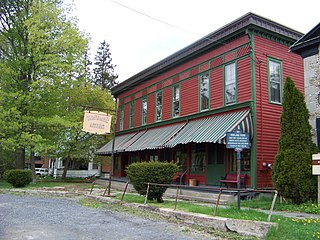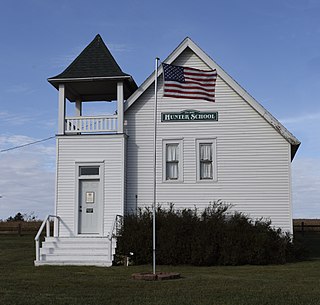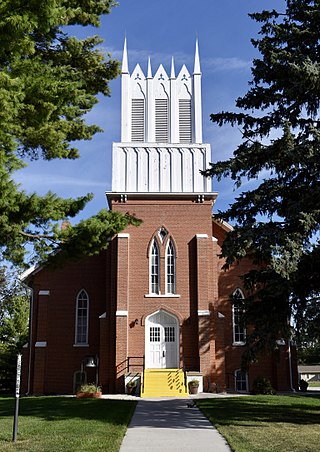
Tabor is a city in Fremont County and extends northward into Mills County in the U.S. state of Iowa. The population was 1014 at the time of the 2020 census.
John Todd was an American Congregationalist minister, co-founder of Tabor College in Tabor, Iowa, a leading abolitionist and a conductor on the Underground Railroad.

Blawenburg is an unincorporated community and census-designated place (CDP) located within Montgomery Township, in Somerset County, in the U.S. state of New Jersey. As of the 2010 United States Census, the CDP's population was 280. It is located at the juncture of two large roads, CR 518 and CR 601.

Mount Tabor is an unincorporated community and census-designated place (CDP) in Parsippany–Troy Hills Township, Morris County, New Jersey, United States. As of the 2020 census, the population was 1,244. The community was originally established as a self-governing Methodist camp meeting site.

The Savannah Historic District is a large urban U.S. historic district that roughly corresponds to the pre–Civil War city limits of Savannah, Georgia. The area was declared a National Historic Landmark District in 1966, and is one of the largest urban, community-wide historic preservation districts in the United States. The district was established in recognition of the Oglethorpe Plan, a unique model of urban planning begun in 1733 by James Oglethorpe at Savannah's founding and propagated during the first century of the city's growth.

The Green–Meldrim House is a historic house at 14 West Macon Street, on the northwest corner of Madison Square, in Savannah, Georgia. Built in 1853, it was designated as a National Historic Landmark in 1976 as one of the American South's finest and most lavish examples of Gothic Revival architecture. The house is owned by the adjacent St. John's Episcopal Church, which offers tours and uses it as a meeting and reception space.

Center Township is one of ten townships in Marshall County, Indiana, United States. As of the 2020 census, its population was 15,601 and it contained 6,447 housing units.

The Leadville Historic District is in the mining town of Leadville, Colorado. The National Historic Landmark District includes 67 mines in the mining district east of the city up to the 12,000 foot level, and a defined portion of the village area. It was designated in 1961. Then, when the National Register of Historic Places (NRHP) program was started in 1966, Leadville's National Historic District was included in its first day's listings, along with all other existing National Historic Landmarks. The NRHP district was later expanded, adding a number of structures along the Harrison Avenue corridor, and making them eligible for historic preservation grants and tax subsidies, too.

Bean Blossom Township is one of eleven townships in Monroe County, Indiana, United States. As of the 2010 census, its population was 2,916 and it contained 1,184 housing units.

The Mount Pleasant Historic District encompasses the historic center of the village of Mount Pleasant, Ohio. Founded in 1803 by anti-slavery Quakers, the village was an early center of abolitionist activity and a well-known haven for fugitive slaves on the Underground Railroad. The village center is relatively little altered since the antebellum period. The district was listed on the National Register of Historic Districts in 1974, and was designated a National Historic Landmark in 2005.

The Nashville Historic District in Nashua, New Hampshire is a historic district that was listed on the National Register of Historic Places (NRHP) in 1984. It encompasses an area just north of downtown Nashua, roughly centered on the junction of Concord, Amherst, and Main streets. Its southern bound is the Nashua River and Railroad Square, its eastern bounds are Railroad Square, Clinton, Lock, Orange, and Concord streets, its northern bound is Mount Pleasant Street, and its western boundary is Abbott, Amherst, Concord, and Main streets between the northern and southern bounds.

This is a list of the National Register of Historic Places listings in Todd County, Minnesota. It is intended to be a complete list of the properties and districts on the National Register of Historic Places in Todd County, Minnesota, United States. The locations of National Register properties and districts for which the latitude and longitude coordinates are included below, may be seen in an online map.

There are 77 properties listed on the National Register of Historic Places in Albany, New York, United States. Six are additionally designated as National Historic Landmarks (NHLs), the most of any city in the state after New York City. Another 14 are historic districts, for which 20 of the listings are also contributing properties. Two properties, both buildings, that had been listed in the past but have since been demolished have been delisted; one building that is also no longer extant remains listed.

Sherwood Equal Rights Historic District is a national historic district located at Sherwood in Cayuga County, New York. The district consists of 29 properties containing 27 contributing primary buildings, one contributing site (cemetery), three contributing carriage houses and one non-contributing building in the historic core of the hamlet of Sherwood. It encompasses the entire hamlet and includes several commercial / civic structures at the intersection of New York State Route 34B and Sherwod Road. The structures commemorate the historical Quaker community's dedication to abolition, women's rights, and education.

The Riverview Terrace Historic District is a 15.2-acre (6.2 ha) historic district in Davenport, Iowa, United States, that was listed on the National Register of Historic Places in 1984. It was listed on the Davenport Register of Historic Properties in 1993. The neighborhood was originally named Burrow's Bluff and Lookout Park and contains a three-acre park on a large hill.

The Todd House is a historic house museum that was the home to abolitionist and Congregationalist minister, John Todd. The house is located on Park Street in Tabor, Iowa.

Hunter School is a historic building near Tabor, Iowa, United States. The one-room schoolhouse was built in 1901. The school was named for John H. Hunter, a farmer and landowner on whose property the original school was built in 1901. Its use as a schoolhouse came to an end in 1920 when it was consolidated into the Tabor School District. The building was used as a township meeting and a polling place until 1990. Since then it has been maintained as a historical landmark. The former schoolhouse is a frame structure built on a brick foundation, and consists of a 24-by-26-foot main block and an 8-foot (2.4 m) square bell tower-entrance. While the schoolhouse overall follows a basic plan for a one-room schoolhouse, it departs from that plan with the asymmetrically placed corner tower. It was added to the National Register of Historic Places in 2007.

Tabor Congregational Church is a historic Congregational church at 403 Elm Street in Tabor, Iowa, USA.

St. Wenceslaus Parish is a Catholic parish of the Roman Catholic Diocese of Sioux Falls in Tabor, South Dakota in the Midwestern United States. Its historic red brick church, built in 1898, was listed as St. Wenceslaus Catholic Church and Parish House on the National Register of Historic Places on December 13, 1984, as part of a "Thematic Nomination of Czech Folk Architecture of Southeastern South Dakota".

Pleasant Grove Presbyterian Church is a historic building located in Chatham, Iowa, United States. The building's significance is associated with its architecture. The design of the wood frame structure is more reminiscent of a schoolhouse than a church building. There are no church buildings similar in style in the area. F. W. Chapman, of Waterloo, Iowa was responsible for the carpentry work, Tabor Construction Company poured the foundation, and Menzel, also of Waterloo, installed the windows. The windows incorporate the pointed Gothic arch. The building was constructed for $2,910.35.





















